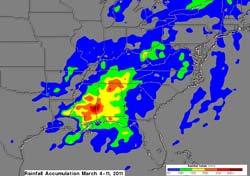TRMM maps flooding along US East Coast from massive storm

Although the heaviest rainfall last week was in the southern United States, flooding was reported in states from Louisiana to northern New York. A rainfall analysis was created made by merging precipitation data from multiple satellites.
This Multisatellite Precipitation Analysis (TMPA) analysis used data that were calibrated with TRMM precipitation data. These data are calculated and stored at NASA Goddard and are available within a few hours after being received by satellites.
The analysis indicated that the greatest total rainfall for the past week was over 300 mm (~11 inches) and was located over Alabama and Mississippi. Some of the extremely heavy rainfall in this area was associated with tornado spawning thunderstorms (see: http://trmm.gsfc.nasa.gov/publications_dir/tornadoes_7-10may11.html).
Much of the eastern United States was affected by rainfall totals of over 50 mm (~2 inches). As the weather system moved east, some of the most impressive rainfall totals in the Mid-Atlantic fell between Baltimore, Md. and Charlottesville, Va. On Thursday, March 10, Baltimore set a new daily rainfall record measuring 2.61 inches according to the National Weather Service. Charlottesville received 2.33 inches of rainfall from the system. To the west, Martinsburg, West Virginia also reported a daily record rainfall total of 1.26 inches. Many areas had flooding with totals that were less than the extreme amounts shown on the rainfall analysis.
Hal Pierce/Rob Gutro
NASA's Goddard Space Flight Center
Media Contact
All latest news from the category: Earth Sciences
Earth Sciences (also referred to as Geosciences), which deals with basic issues surrounding our planet, plays a vital role in the area of energy and raw materials supply.
Earth Sciences comprises subjects such as geology, geography, geological informatics, paleontology, mineralogy, petrography, crystallography, geophysics, geodesy, glaciology, cartography, photogrammetry, meteorology and seismology, early-warning systems, earthquake research and polar research.
Newest articles

Superradiant atoms could push the boundaries of how precisely time can be measured
Superradiant atoms can help us measure time more precisely than ever. In a new study, researchers from the University of Copenhagen present a new method for measuring the time interval,…

Ion thermoelectric conversion devices for near room temperature
The electrode sheet of the thermoelectric device consists of ionic hydrogel, which is sandwiched between the electrodes to form, and the Prussian blue on the electrode undergoes a redox reaction…

Zap Energy achieves 37-million-degree temperatures in a compact device
New publication reports record electron temperatures for a small-scale, sheared-flow-stabilized Z-pinch fusion device. In the nine decades since humans first produced fusion reactions, only a few fusion technologies have demonstrated…





















